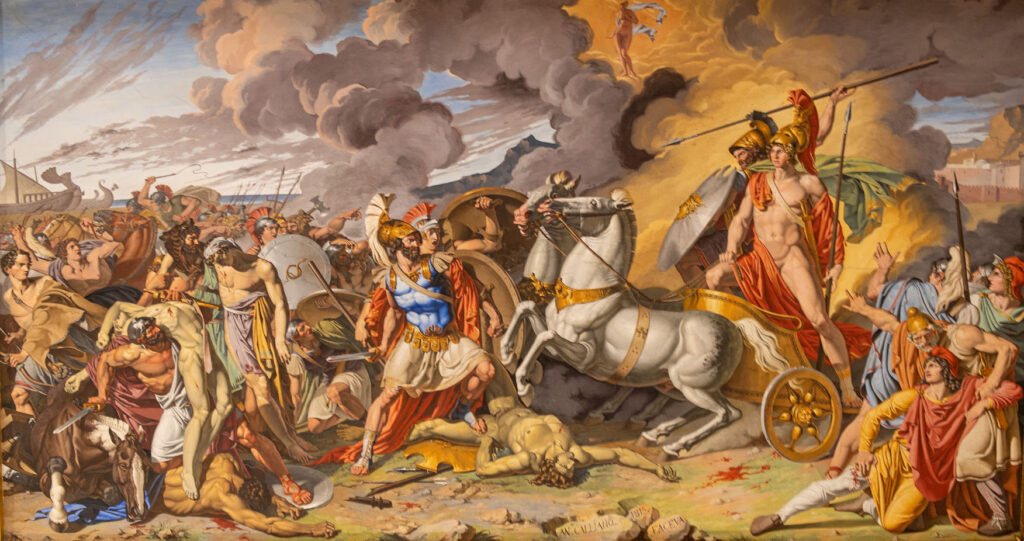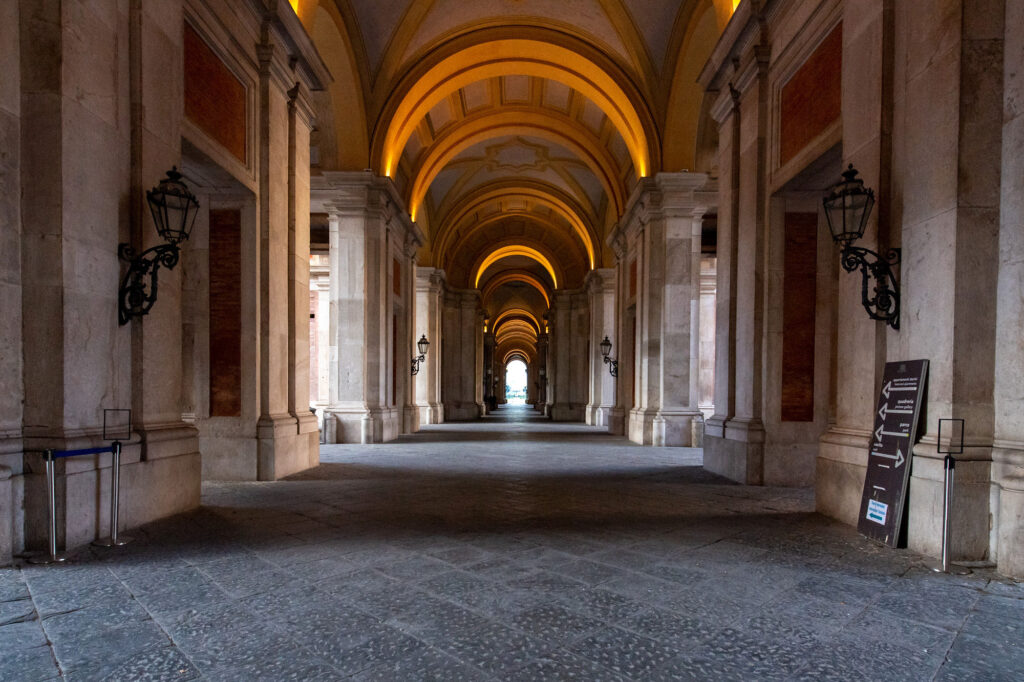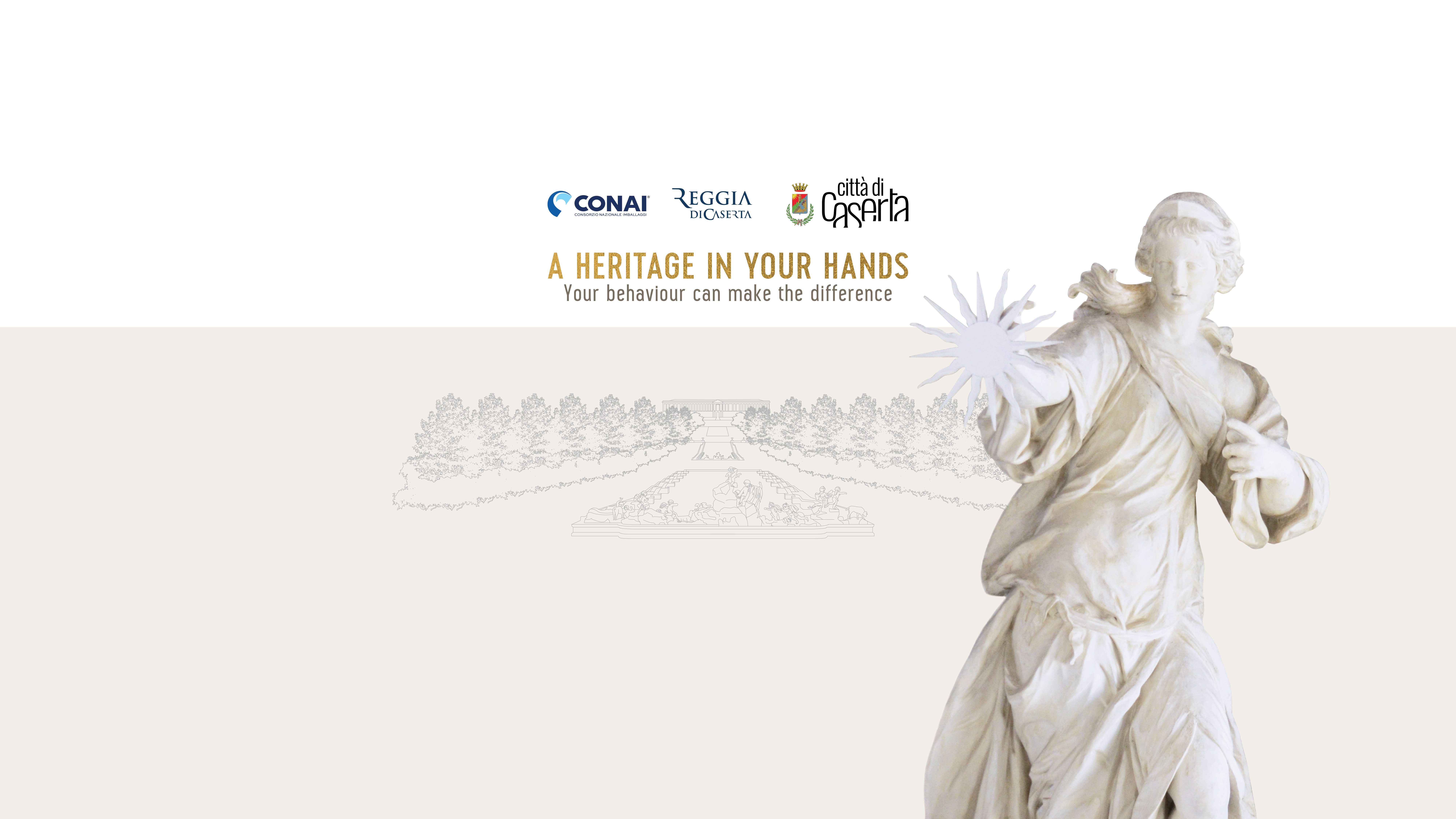
CONAI Campaign “A Heritage in your hands”
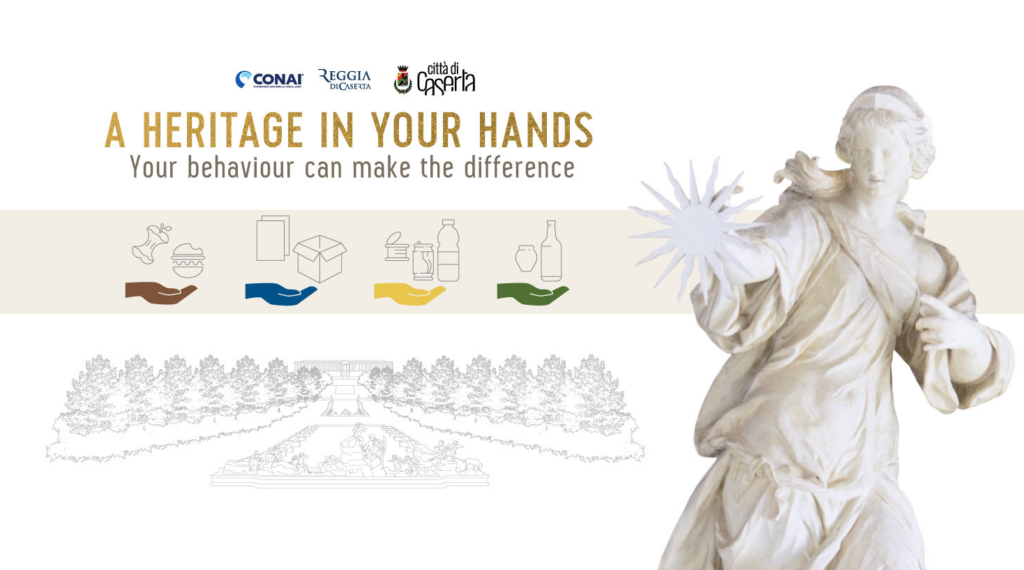
“A heritage in your hands” is a project that combines together, the values of CONAI and the values of UNESCO, to preserve the Italian artistic and cultural heritage.
Proper separate collection is synonymous with taking care of what is closest to our hearts and therefore to ourselves, as individuals and as a community.
Through this campaign, CONAI provides visitors to the Reggia di Caserta with the right and correct indications for the waste separation and disposal, starting from our history, an added value to the Italian cultural heritage.

Separate collection was born in Naples!
Contrary to what is commonly thought, at the turn of the Industrial Age, the Bourbon South had developed a series of very punctual regulations and decrees to manage separate waste collection, for safety, but also for the hygiene of all citizens.
The Reggia di Caserta sees the light and lives according to these enlightened principles.
Waste separation mainly focused on glass and wet waste, which was set aside for what we might call the first compost experiments.
History and its teachings give us one more reason to be more careful, today more than ever, given the widespread presence of so-called “multi-materials” in our daily lives.
The kings and queens who lived in the Reggia di Caserta over time have determined its magnificence and glory also thanks to a particular attention to the knowledge and correct management of waste.



Waste separation at the time of the Kingdom of the Two Sicilies. Did it exist? Absolutely, yes!
Precisely during the Kingdom of the Two Sicilies, in fact, and in particular on May 3, 1832 , it is believed that it was King Ferdinand II of Bourbon himself who issued a decree signed by the then prefect of police, Gennaro Piscopo , which analyzed and regulated the entire hygienic situation of Neapolitan waste, to protect public health. In this decree, belonging to the ” Collection of Laws and Decrees of the Kingdom of the Two Sicilies “, shopkeepers and citizens of the time were obliged to clean up the streets adjacent to homes or shops. In the original language of the time it read as follows: “All owners or tenants of houses, shops, gardens, courtyards, and fixed or mobile places, will have the obligation to sweep up the extension of the street corresponding to the front of the respective house, shop, courtyard, and for the projection not less than ten palms away from the wall, or from the respective place. This sweeping must be carried out each morning before sunrise, taking care to pile up the rubbish next to the respective houses, and to separate all the fragments of crystal or glass that you find, placing them in a heap at part”. A real separate collection!
The decree was made up of 12 articles which indicated the method of collection as well as the penalties for those responsible for the infringement of these regulations. Indeed, in one of the articles, it was forbidden to throw materials of any kind from the balconies. It was also forbidden to throw the water from the toilets and it was not even possible to wash or hang clothes along the inhabited streets. Anyone who violated this decree was punished with heavy fines or even, in some cases, with imprisonment.
Furthermore, in the Kingdom of Naples, the textile sector with the production of wool and silk and heavy manufacturing , with the birth of the ironworks, represented the first proto-industrial nucleus that would give birth to the Modern Age. It is here that the first paths of reconversion and recovery of materials are identified for the first time: in particular, the Reggia di Caserta represents a propulsive fulcrum that also radiates to the rest of the province; in fact, stone and tuff quarries were opened, the crops for horses and livestock multiplied, as well as carpentry shops capable of producing objects, all types of work and various supplies. After all, in 1774 the Royal Palace alone absorbed over 2,000 workers.
It can be said, without fear of being wrong, that practically everything was recycled at the time of the Bourbons!
Also on the wood there were decidedly ante litteram policies of respect and recovery of the material .
Before the Kingdom of the Two Sicilies – and the mandate to the architect Gioffredo – intensive exploitation of the woods had always been carried out to obtain wood charcoal. This behavior led to a rapid depletion of timber.
The proto-industrial complexes, and in particular the ironworks, were therefore conceived as a stable settlement, in an area where all the factors of production were present: ore, timber, perennial waterways with sustainable management.



 Typology of materials
Typology of materials

Organic Waste and Compostable Bioplastics
WHAT TO DIFFERENTIATE
YES
Vegetable and animal kitchen scraps, egg shells, coffee and tea grounds, food-stained paper napkins, leaves, dried flowers, cork stoppers, compostable baking paper, compostable crockery and cutlery. Compostable bioplastic packaging bearing one of the compostability marks (on the single object or on the package).
NO
Synthetic animal litter, sanitary pads, chewing gums, cigar or cigarette butts, used vegetable oil, plastic bags. In general everything that is not organic (e.g. containers, jars, cans, pots and bottles, liquids)
HISTORICAL BACKGROUND
There is certain information that since 1787 in Naples, in the city and in the countryside, the recycling of food was carried out. It was probably used to create compost to cultivate the land. Naples was the cleanest city in Europe, about 150-180 years ago, before the unification of Italy, thanks to its avant-garde laws!
In particular, in article no. 3 of the edict of May 3, 1892, the “owners, renters of stables or sheds” were ordered to remove the manure every day and to deliver it in the places indicated by the Police Commissioners.
A feature of this first model of sorting in the Kingdom of Naples is precisely the ability to manage “pluriactivity”, in particular through the integration between proto-industry and agriculture . A real process of virtuous pluriproduction !
The different lineages of the proto-industrial communities over the years go beyond the exclusive wool production to produce, in different months of the year, pasta, but also paper, with the mills being adapted for both types of production.
Large investments by the Bourbons, even in the first examples of steam plants, allow the pasta factories in the province of Naples to achieve incredible results, in Italy and abroad, with mills used for production for each market.
In the Bourbon era we therefore find the first examples of “complete cycle” plants , which made it possible to manage the entire production, from cereals to pasta, with minimal waste!
Today, food and vegetable waste represent an important part of our waste, which is also essential for acting in terms of reducing and recovering a precious resource for the circular bio-economy.
In this sector, a key role is also played by compostable bio-plastics: an innovative and sustainable material, developed above all for applications in the field of food packaging. After being used several times, compostable bio-plastic packaging must be collected together with organic waste, so that it is treated in the appropriate plants and transformed into biogas and compost, a precious natural fertilizer for the soil.




Paper Cardboard and Cardstock
WHAT TO DIFFERENTIATE
YES
Corrugated cardboard and cardboard packaging always flat, clean pizza boxes, paper bags, newspapers, commercial printed sheets of paper, sheets of paper of all sizes, cardboard bands, paper or cardboard parts of packages.
NO
Receipts, greaseproof paper, laminated paper, baking paper, used paper tissues, cardboard packaging with food or earth residues or soiled with chemicals, plastic bags and compostable bioplastic. Generally everything that is not paper. The cartons for liquids must be delivered with plastic, steel and aluminium.
HISTORICAL BACKGROUND
At the time of the Kingdom of Naples, the paper industry represented one of the most flourishing production poles of the whole empire, so much so that we speak of the “great era” of the Ancient Paper Mills. In fact, there were about two hundred paper mills throughout the Kingdom.
The paper industry actually arrived in Europe, from the Ancient East, as early as the 11th century, with the famous Fabriano . After the plague of 1600 this industry had to fight with a long setback: paper was in fact produced starting from rags, but, to stop the contagion, these were burned, thus effectively eliminating the raw material. It was Holland, in 1800, to start the production of cellulose from wood, after attempts with nettle, fern, hops and corn, which gave little results. In 1880, a process was invented which also made it possible to obtain very sturdy paper: Kraft paper, a real revolution in the world of packaging. Thanks to wood pulp, paper production became mass-produced, with the consequent fall in price that transformed it from a luxury product to a consumer product.
Meanwhile, in the flourishing Kingdom of the Two Sicilies paper industries multiplied together with the factories. Campania in 1860 was the most industrialized region of Europe, particularly the Neapolitan area, along the Caserta – Salerno axis. In it there were both the grandiose Pietrarsa factory where steam engines, locomotives, railway carriages and tracks were produced, and the famous shipyards among the best ones in Europe, arms and tool factories, chemical companies, and finally the industries for the production of paper, glass, tanning and leather, food, ceramics and building materials.
We cannot talk about paper without immediately referring to the story of one of its main products: packaging! Its origins can be traced back to the late eighteenth century when the Industrial Revolution ushered in massive changes in the manufacturing industry. The introduction of large-scale mechanization allowed the production of increasingly large quantities of items and thus the need arose to protect and preserve them, preventing their damage during transport, and consequently their recovery!
Closely linked to those of paper were the “industries” of books, the printing houses: over 400 titles were published annually, a real record in Italy at the time! In Naples in 1833 there were about 120 active printing houses! In 1848 there were strikes in Naples just among the numerous workers in the typographies. The production of paper ranged from fine paper, known as “ di bambace ” because it is watermarked and soft, used for judicial and public documents instead of parchments, up to “strazzo” or ” straccia ” or ” emporica ” paper, which was widely consumed by fishmongers, greengrocers and butchers to wrap their products in the ancient ” cuoppi “. The presence of dedicated productions according to the intended use of the material creates the basis for a first culture of recovery and therefore of reuse.
Finally, there were also numerous “hand paper mills” , which processed artisanal black or coloured cotton rags to produce wrapping paper and cardboard.



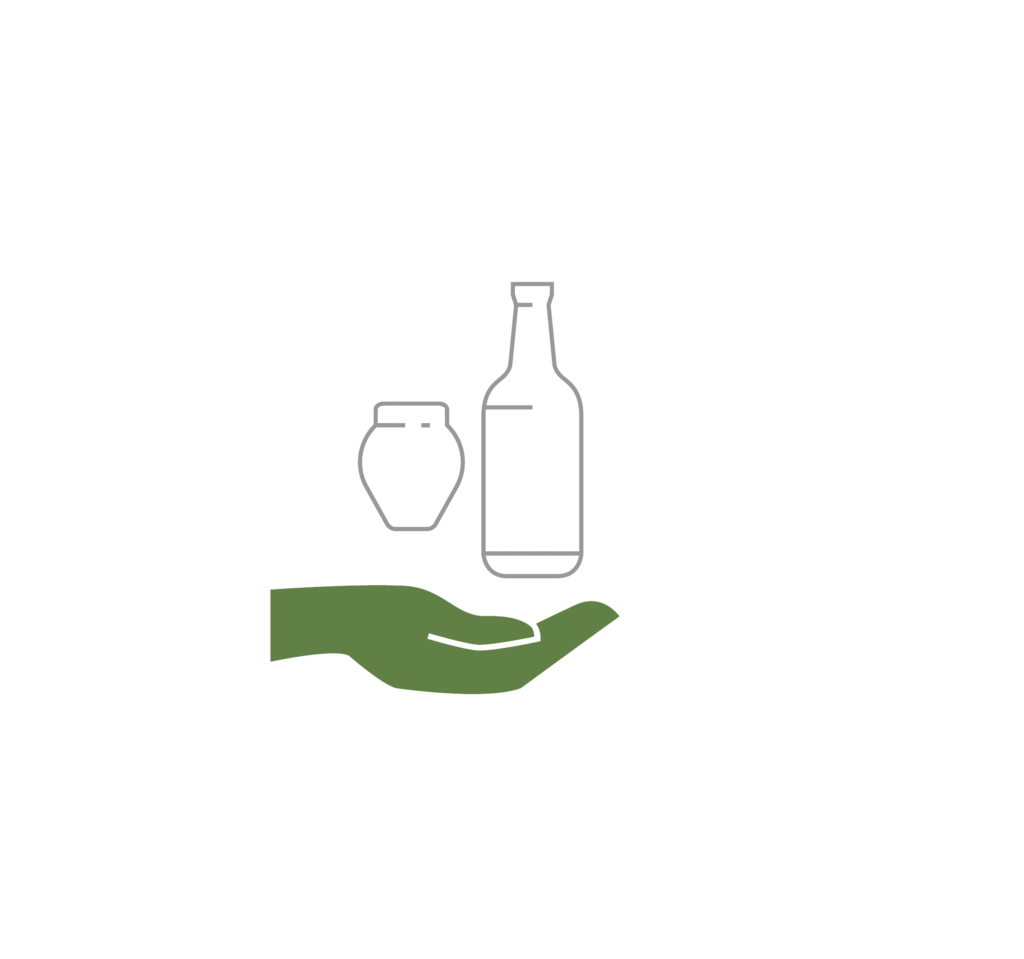
Glass
WHAT TO DIFFERENTIATE
YES
Bottles, jars, little jars, small bottles and bottles. Containers must be empty and without caps of any kind (metal, plastic, cork).
NO
Plastic bags, glass beakers, ceramic and porcelain objects, glass ceramic containers (borosilicate glass, etc.)
HISTORICAL BACKGROUND
Attention to the disposal of glass is in the incipit of the decree of May 3, 1832.
This was accompanied by an ordinance from the police prefecture which regulated, in detail, the sweeping and watering of the streets, including a sort of “separate collection” for the glass that was recovered and recycled from the numerous glass factories existing in the kingdom. It was done for the safety of citizens, as one could be injured by pieces of crystal or broken glass.
The industrialization of wine and oil production during the Bourbon Kingdom exerted a very strong driving force to the use of glass for packaging as we know it today, thus determining particular attention to its disposal which, as we have seen, could easily become dangerous if not delivered properly.
But there’s more! In the Bourbon age we also know attempts to recover and therefore to recycle glass. Until modern times, in fact, the second phase of glass production took place in the so-called “secondary” workshops, which gave shape to a large range of objects starting from “raw” glass to which shards of recycled glass were added, also useful for lowering the melting point of the batch.
In this way, part of the raw glass from primary production was also reused as well as the glass from the so-called secondary production, which, starting from unprocessed glass, in fact, or integrated with recycled materials, made it possible to model objects ready to be marketed.
Glass recycling is an extremely virtuous process: the recycled material can in fact replace the original raw material without any loss of quality. Glass can be recycled an infinite number of times, 100% , without any loss of material and indeed, with a significant reduction in the energy consumption necessary to produce this material from scratch .
Throwing the glass into the appropriate containers , without dispersing it in the environment, helps to maintain a healthy and clean environment.



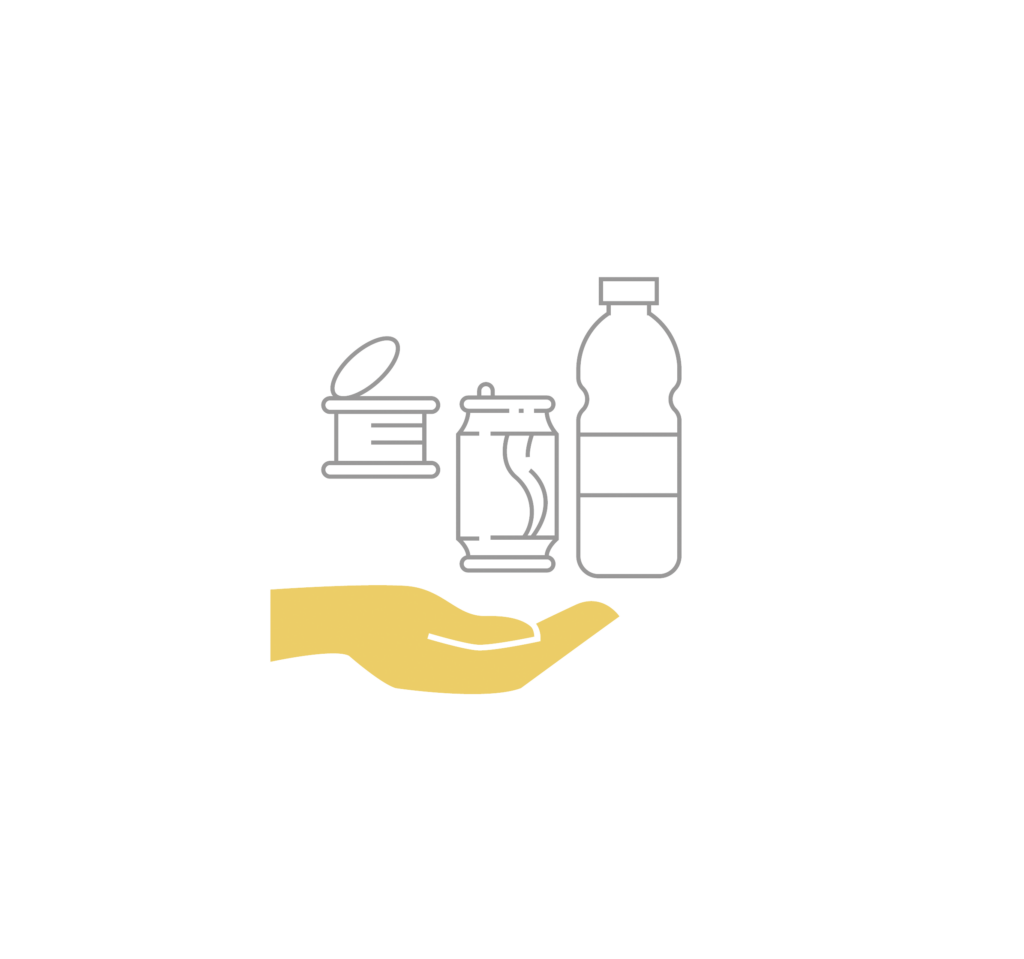
Plastic and Metals
WHAT TO DIFFERENTIATE
YES
Plastic bottles, food and yogurt pots, packaging films and polystyrene, food envelopes and bags, cans, spray cans (empty), boxes, tins, metal cans and jars (steel and aluminium), caps and lids, trays , aluminium plates and trays, combined paper and aluminium containers.
NO
Bulky plastic goods, household appliances and their parts, plastic cutlery, rubber objects, CDs, DVDs, films and compostable bioplastic bags.
HISTORICAL BACKGROUND
At the time of the Bourbons, steel was already known, but plastic and aluminium had not been born yet , and the concept of packing and packaging was still developing in the context of proto-industrial realities. Plastic as we know it only arrived in the 20th century, and for a long time it was considered the “black sheep” of recycling, but today we know well that with proper separate collection, plastic can actually be reborn to new life!
The history of plastic only begins in the 19th century, when, between 1861 and 1862, the Englishman Alexander Parkes, developing his studies on cellulose nitrate, isolated and patented the famous “xylonite”. It was 1870 when the American brothers Hyatt patented the celluloid formula, with the aim of replacing the expensive and rare ivory in the production of billiard balls. History has it that the new material met with immediate success with dentists as a material to be used for dental impressions. It is the 20th century that is to all intents and purposes the century of plastics, since studies on this material also find a scientific foundation. Its flexibility, transparency and non permeability are explored, which immediately find application in the field of packaging: the Swiss Jacques Edwin Brandenberger invents Cellophane , a cellulose-based material produced in very thin and flexible sheets. The 1930s and the Second World War marked the passage of “plastic” to “adulthood”, above all as regards the creation of a truly modern industry: petroleum became the “raw material” from which to start production and, at the same time, processing techniques improve and adapt to mass production, starting with moulding: nylon (polyamide), polypropylene, acetates and various polymers are born. Today we can even talk about technopolymers, which allow sophisticated and unthinkable applications in all industrial fields.
Tinplate, the type of steel used to produce packaging in this material, began to be processed between the end of the 1200s and the early 1300s. However, this raw material for packaging established itself between the end of the 1700s and the beginning of the 1800s , that is, when the technique of preserving canned foods is studied and developed.
As far as Bourbon history is concerned, the Reali Ferriere (Royal Railways) and Officine Borboniche di MOngiana (Bourbon workshops in Mongiana, in the province of Vibo Valentia in Calabria, represented the most important and daring iron and steel pole of the Kingdom.
Another district worthy of note is the Ferriere del Savone (Savone Railways), in Teano. Between 1830 and 1845, in the first years of the reign of Ferdinand II, a series of small, medium and large industries arose along the course of the Savone river including, in the locality of Gomite, an iron and copper works commissioned by the industrialists Nicola and Bartolomeo Salvi. The Ferriere del Savone were the first railways, thanks to the inventiveness of the “Real Istituto d’Incoraggiamento di Napoli”(Royal Institute of Encouragement), in itroducing the use of blast furnaces in the iron and steel industry.
The Bourbon proto-industries, in fact, produced metal construction components for the construction of large infrastructures, such as bridges and, unique excellence, the rails of the first Italian railway section.
In 1861 the steel produced in Mongiana received a prize for the Industrial Exhibition of Florence, and the following year at the International Exhibition in London cast iron, iron and weapons such as sniper rifles and sabres were awarded. Steel is recycled endlessly!
Aluminium, on the other hand, has only been used on an industrial level since 1886; today it is one of the favorite materials for canning in the food sector, because it is flexible, light and suitable for contact with food. Aluminium is the third most abundant element after oxygen and silicon and its characteristic is that it can be recycled … indefinitely! 75% of all aluminium ever produced in the world is still in use. In order to be recycled, the aluminium is pressed into bales and then sent to the foundry where the material , pre-treated at around 500°, for the purpose of being purged of paints or other substances, is melted at 800°, in order to obtain liquid aluminium, ready to generate the famous “plates”, intended to be processed for producing semi-finished products and new artefacts.
The aluminium recycling process makes us understand how important it is for metals to be well separated from other materials, in particular from those that go into the undifferentiated waste.




Non-recyclable
WHAT TO DIFFERENTIATE
YES
Diapers and incontinence diapers, sanitary pads, nylon stockings, non-recyclable rags, butts of cigarettes, DVDs, razors, brushes, laminated and baking paper, plasters, chewing gums, thermal receipts.
NO
All separable and recyclable materials (glass, paper, cardboard and cardboard, plastic, steel and aluminium, organic material), textiles, medicines, batteries and accumulators, used vegetable oil, wood.
HISTORICAL BACKGROUND
Although the concept of undifferentiated waste has existed since the Neolithic Age, the necessity to understand the nature of man-made materials began to be really perceived in the pre- industrial era , when the morphology of urban agglomerations began to change drastically.
During the 1800s, in fact, the massive urbanization of cities began and the advent of the industrial revolution acted as an attraction for poor populations, who moved from the countryside to the cities to look for work, thus causing a disproportionate growth in inhabitants.
In 1832, a cholera epidemic broke out in London and also in Paris, causing tens of thousands of deaths. The absence of proper management of materials undoubtedly contributed to the health emergency. Although not knowing the causes of death of the population, the problem was attributed to the great stench of open-air landfills, including roads and rivers, which received all the organic waste, but also the industrial waste.
In the 19th century the construction of the first sewers began and microbiological studies were carried out in order to find effective answers to the problem of water purification. In general, towards the end of the century, awareness of personal hygiene also improved and the first vaccinations arrived.
As regards solid, non-recoverable materials, which were normally deposited outside domestic environments, the growth of the population in the new urban agglomerations led to new problems and the need to better understand how to dispose of them.
The unsorted rubbish began to pile up, however. The colonies of mice lived in close contact with the populations of the poorest neighbourhoods, attracted by the materials thrown freely in the city streets, creating further health problems.
It was precisely Ferdinand II of Bourbon who, with the edict of 1832 in the kingdom of the Two Sicilies, issued a specific rule that regulated the management of urban materials, providing for severe rules on their abandonment in the street and imposing their separation.
The royal decree envisaged, as seen, very severe prison sentences for offenders. Ferdinand II also set up landfills where people had to bring their materials.
With the advent of separate waste collection systems, undifferentiated waste becomes a non-differentiable fraction and if correctly identified and placed in dedicated containers, it improves the quantity and quality of the other materials collected separately.









